Area of a Trapezoid
This lesson will show you how we find the area of a trapezoid using two different methods.
- Cutting up a trapezoid and rearranging the pieces to make a rectangle and a triangle.
- Using the formula for finding the area of trapezoids.
The first method will help you see why the formula for finding the area of trapezoids work.
Let us get started!
Draw a trapezoid on graph paper as shown below. Then, cut the trapezoid in three pieces and make a rectangle and a triangle with the pieces.
The figure on the left shows the trapezoid that you need to cut and the figure on the right shows the rectangle and 1 triangle.
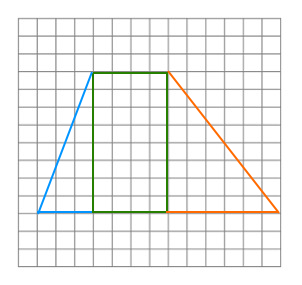
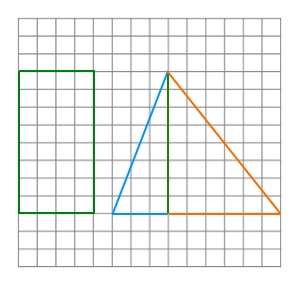
Then, we need to make the following four important observations.
1.
Rectangle
Base = 4
Height = 8
2.
Trapezoid
Length of bottom base = 13
Length of top base = 4
Height = 8
3.
Newly formed triangle (made with blue and orange lines)
Length of base = 9 = 13 - 4 = length of bottom base of trapezoid - 4
Height = 8
4.
Area of trapezoid = area of rectangle + area of newly formed triangle.
Now our strategy will be to compute the area of the rectangle and the area of the newly formed triangle and see if we can make the formula for finding the area of trapezoid magically appear.
Area of rectangle = base × height = 4 × 8
Area of triangle = ( base × height ) / 2
Area of triangle = [(13 - 4) × 8 ] / 2 = [13 × 8 + - 4 × 8] / 2
Area of triangle = (13 × 8) / 2 + (- 4 × 8) / 2
Area of trapezoid = 4 × 8 + (13 × 8) / 2 + (- 4 × 8) / 2
Area of trapezoid = 8 × (4 + 13 / 2 + - 4 / 2)
Area of trapezoid = 8 × (4 - 4 / 2 + 13 / 2)
Area of trapezoid = 8 × (8 / 2 - 4 / 2 + 13 / 2)
Area of trapezoid = 8 × (4 / 2 + 13 / 2)
Area of trapezoid = (4 / 2 + 13 / 2) × 8
Area of trapezoid = 1 / 2 × (4 + 13 ) × 8
Let b1 = 4 let b2 = 13, and let h = 8
Then, the formula to get the area of trapezoid is equal to 1 / 2 × (b1 + b2 ) × h
Trapezoid area formula
In general, if b1 and b2 are the bases of a trapezoid and h the height of the trapezoid, then we can use the formula below. The area of a trapezoid is half the sum of the lengths of the bases times the altitude or the height of the trapezoid.
The bases of the trapezoid are the parallel sides of the trapezoid. Notice that the non-parallel sides are not used to find the area of a trapezoid.
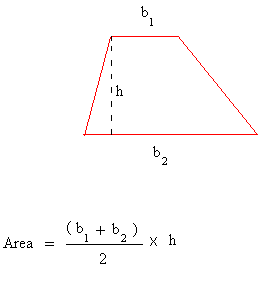
The area is expressed in square units.
- If the bases and the height are measured in meters, then the area is measured in square meters or m2.
- If the bases and the height are measured in centimeters, then the area is measured in square centimeters or cm2.
- If the bases and the height are measured in feet, then the area is measured in square feet or ft2.
Examples showing how to find the area of a trapezoid using the formula
Example #1:
If b1 = 7 cm, b2 = 21 cm, and h = 2 cm, find the area of the trapezoid
Area = 1 / 2 × (b1 + b2 ) × h = 1 / 2 × (7 + 21) × 2 = 1 / 2 × (28) × 2
Area = 1 / 2 × 56 = 28 square centimeters or 28 cm2
Example #2:
If b1 = 15 cm, b2 = 25 cm, and h = 10 cm, find the area of the trapezoid
Area = 1 / 2 × (b1 + b2 ) × h = 1 / 2 × (15 + 25) × 10 = 1 / 2 × (40) × 10
Area = 1 / 2 × 400 = 200 square centimeters or 200 cm2
Example #3:
If b1 = 9 inches, b2 = 15 inches, and h = 2 inches, find the area of this trapezoid
Area = 1 / 2 × (b1 + b2 ) × h = 1 / 2 × (9 + 15) × 2 = 1 / 2 × (24) × 2
Area = 1 / 2 × 48 = 24 square inches or 24 in.2
Area of a trapezoid when the height is missing or not known
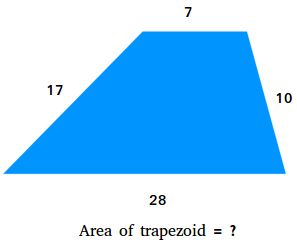
Suppose you only know the lengths of the parallel bases and the lengths of the legs of the scalene trapezoid shown above. How do you find the area? You need to make a rectangle and a triangle with the trapezoid.
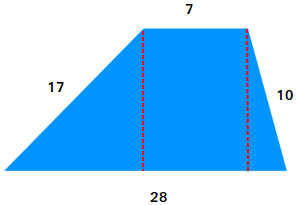
Cut the trapezoid into 3 pieces, a rectangle, and two right triangles. Then, bring together the two right triangles and make only 1 triangle. You will end up with a rectangle and a scalene triangle.
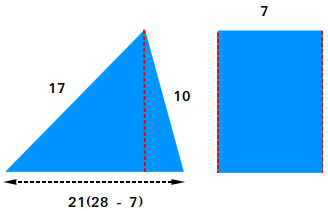
Use Heron's formula to find the area of the scalene triangle.
Area = √[s × (s − a) × (s − b) × (s − c)], s = (a + b + c)/2
a = 17, b = 10, and c = 21
s = (17 + 10 + 21)/2 = 48/2 = 24
s − a = 24 − 17 = 7
s − b = 24 − 10 = 14
s − c = 24 − 21 = 3
s × (s − a) × (s − b) × (s − c) = 24 × 7 × 14 × 3 = 7056
√(7056) = 84
Area of the scalene triangle = 84
Use the area of the scalene triangle to find the height of the triangle. Notice that the base of the triangle is 21 and the height h of the scalene triangle is also the missing side of the rectangle.
84 = (21 × height) / 2
168 = 21 × height
168 / 21 = height
Height = 8
Area of rectangle is 8 × 7 = 56
Area of trapezoid = area of the scalene triangle + area of rectangle = 84 + 56 = 140